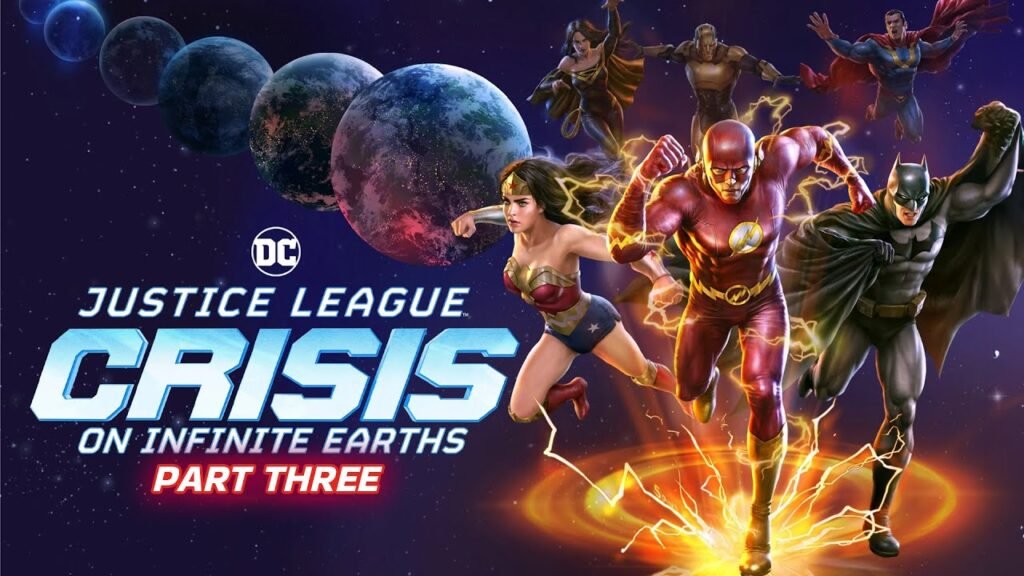
Justice League: Crisis on Infinite Earths – Part Three
Superhero stories are being sacrificed on the altar of “enough” that’s what’s happening. It’s “enough” to sprinkle diversity across select monthly comics while letting the old, white guard rest on its laurels. It’s “enough” to churn out post-Endgame MCU material that does little more than tease its audience. In the case of DC’s animated Tomorrowverse series, it’s “enough” to expect disjointed animated lead-ins that pump fans up for multi movie crossover events. But what if Justice League: Crisis on Infinite Earths – Part Three, the ending of one such event, is dead on arrival?
Writer Marv Wolfman and artist George Perez built their 12-issue Crisis on Infinite Earths comic event around a central goal: unify DC continuity. And director Jeff Wamester’s three pronged attempt at putting that story on screen is successful in that regard: It does reset DC’s animated timeline, but it does so in the most soulless way possible; The action lacks focus and verve and imagination, the performances are earnest but unremarkable; I’ll forgive stake-free storytelling if it manages some fun. Crisis doesn’t. But hey, it gets us from point A to B, so that’s “enough.”
The film picks up with the multiversal war spread across Parts One and Two: Cookie cutter baddie Anti Monitor (Ato Essandoh) is wiping out every version of the Justice League, leaving Bruce Wayne/Batman (mostly Jensen Ackles but also late-stage Kevin Conroy gracing our earholes in his brief final appearance as Batman) to sleuth his way toward a solution that will prove costly for the Justice League. Most strikingly, it tees up emotions we don’t explore enough. Through Supergirl (Meg Donnelly), Part Three tries to communicate something about what it means to be these heroes. Not just of every world, but their own pasts, their own fumbles and fears. But we don’t spend enough time with Supergirl for her arc to matter, in this rushed state it’s treated like a checklist of things that have to happen to her, rather than a story to be told, nurtured, lived in. I don’t think this is intentional (no one sets out to make a bad movie), nor do I think any of the above examples are rooted in smarminess or a desire to cheat audiences out of a good time.
Wamester, writer Jim Kreig and company want their Crisis to stick you can hear it in Kevin Riepl’s somber score, Riepl lingers on those quiet moments where the characters grasp how profoundly screwed they are, creating an atmosphere of foreboding that hints at a more resonant viewing experience. But because Part Three never lets these scenes or any other scene, for that matter breathe, they don’t live up to the fanfare. A major death in the final half hour (you’ve read the comics; you probably know) gets lost in a flurry of characters and terminology that isn’t sufficiently explained. For an adaptation of the story that popularized the multiverse concept almost 40 years ago Part Three is instead an unnecessarily flat, dull mess that snuffs out any excitement I may have had for what’s next from DC animated movies.
On screen, it’s a bummer too. The cartooning of the Tomorrowverse feels like the animated movie version of overwriting so much so that it bleaches out the pain, the power, the sheer force of will from these characters and their worlds and leaves us with 2D husks running around fighting for shit we don’t care about. The animation is so shiny, so glossy, that you can’t help but wish they had gone for something even remotely resembling the emotional tempest Perez could convey in a single panel.
It’s a shame that story doesn’t work visually because there are plenty of opportunities to go all out and all in with its spectacle. Once the Anti-Monitor’s weaknesses become clear to the Justice League, we see several heroes step up to confront him and probably destroy themselves while doing it. The Green Lanterns get involved; Superman and other DC mainstays who can survive in space join in; this provides Supergirl (and Part Three itself) an opportunity to square off against this near omnipotent foe. Krieg’s script does not fulfill the inherent promise of a Supergirl/Anti Monitor throwdown but it gets damn close.
Verdict
Justice League: Crisis on Infinite Earths – Part Three cannot escape the overall lifelessness of the Tomorrowverse. It is also a bad send-off for Kevin Conroy’s Batman one that, even at its best moments (Supergirl facing off against Ant Monitor, Green Lanterns throwing everything they have at their all powerful adversaries), does not deliver on the fist pumping hurrah director Jeff Wamester and company so clearly want it to be.
For More Movies Visit Putlocker.